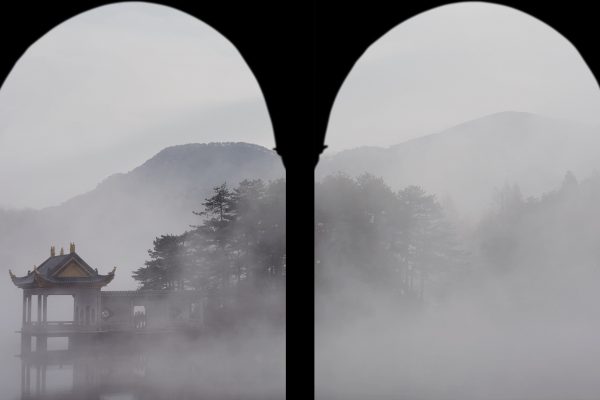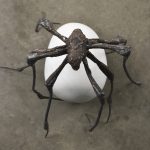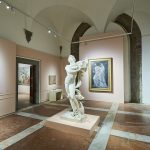Il Tempo Fluido. Che Jianquan

to 17 December 25
This is a series of monumental video projections dedicated to the cyclical nature of time and the relationship between humans and nature. This autumn, the Sala d’Arme of Palazzo Vecchio will host Il Tempo Fluido. This exhibition, produced by MAD Murate Art District – Fondazione MUS.E and Zhong Art International and curated by Valentina Gensini, features the work of Che Jianquan and runs from 20 November to 17 December 2025.
The first chapter of Il Tempo Fluido is an ambitious three-year project, conceived and directed by Gensini and Zhang, which explores leading figures in contemporary Chinese video art. Che’s exhibition occupies the monumental spaces of the Palazzo Vecchio with a selection of his refined video works. Che is a widely respected professor and a principal participant in the China Pavilion at the 60th Venice Biennale (2024), as well as being internationally recognised.
His artistic language combines painting, video, writing, and interactive installation, interweaving traditional Eastern philosophy with contemporary challenges to create a contemplative vocabulary reflecting on natural energy and global crises.
He was selected for his extraordinary, elegantly rendered video productions. The exhibition presents four multichannel works in sequence, totalling approximately one hour of viewing time. The selected videos interweave observation, meditation, and landscape to produce a visual narrative that explores the tensions between modernity and tradition, and between the sacred and the everyday. The works on display follow the fluid rhythm of listening, lingering, and prolonged observation, forming poetic devices that open up spaces for interpretation beyond the imposing arches of the existing architecture.
Jianquan’s work provides an insightful view of contemporary Chinese society, highlighting overlooked aspects and encouraging reflection on socially relevant issues. Fusing traditional elements with technological innovation, his installations reactivate memories and evoke the latent structures that shape relationships between individuals, communities, natural territories, and archaeological testimonies.
During his residency at MAD Murate Art District this autumn, Jianquan will present a new phase of his research to the Italian public for the first time, offering them a space for deep reflection on issues that transcend the contemporary condition, such as the survival of archaic knowledge, the contradictions of rural and industrial development, and the fragility of human and cultural landscapes. The exhibition therefore becomes an experience to be traversed, inviting visitors to re-inhabit time within a frenetic present.
Realised with the support of the Tuscany Region’s “Toscanaincontemporanea2025” programme as part of the Sharing Visions project, the exhibition includes a collaboration with the Academy of Fine Arts of Florence on a special mediation project. Following MAD’s participatory practices, this project will welcome both the Chinese and local communities, as well as the international audience that regularly visits Palazzo Vecchio.
Che Jianquan — Biography
Che Jianquan is a professor and doctoral supervisor at the Guangzhou Academy of Fine Arts, a professor at the Sichuan Institute of Fine Arts and a master’s supervisor at the Tianjin Academy of Fine Arts. He is an interdisciplinary artist whose research ranges across history, sociology, regional culture and image studies. His artistic language encompasses painting, video, writing, and interactive installations. Drawing on specific field studies, he takes an intertextual, contemplative approach that reveals the influence of natural energy and mystery on human spectacle.
Grounded in traditional Chinese philosophy, his work highlights the interconnectedness of humans and the natural world, offering new perspectives on how ancient wisdom can address contemporary issues. His recent exhibitions include the 6th Guangzhou Triennial (2018), the Guangdong International Photographic Art Triennial (2021), the Havana Biennial (2021), the 1st Venice Metaverse Exhibition (2022), the Chengdu Biennial (2023), the Lianzhou International Photography Annual Exhibition (2023), and the Venice Biennale (2024).
Further information is available from the organisers at info@musefirenze.it or on +39 055 2768224.
Works on display
In Pavilion, a project that Che Jianquan has been working on for over a decade, the artist employs a method of repeated observation. He returns cyclically to film a single pavilion in different seasons, at different times of day, and in different conditions. Since 2007, this approach has produced a series of ten videos in which repetition fosters openness rather than uniformity. Through his essential, non-interventionist approach, Che Jianquan aims to suspend jneyavarana, the term used in Zen Buddhism to describe the obstruction to knowing, or the ego-filtered perception that narrows our capacity to grasp the infinite complexity of the world. Fragment by fragment, Pavilion becomes a visual meditation on the mutable nature of reality: repetition reveals the subject’s original, multiple and never definitive form. This work challenges our established categories of vision and demonstrates how every act of perception is a form of transformation.
Interwoven with this reflection on transformation is Meditation of Uncertainty, which was conceived in response to the global crisis triggered by the pandemic. The interruption of daily routines, the erosion of certainties, and the emergence of an unpredictable future have made the fragility that connects humans to their surroundings tangible. Set in Macao’s casinos, the film uses gambling as a metaphor for contemporary existence, which is governed by probability, fortune and risk. Through the contrasting responses of two characters, A and B, the film explores the limits of human knowledge and reveals the loneliness lurking beneath collective frenzy. Here, uncertainty is not a place of disorientation, but a space of awareness — an invitation to pause within not-knowing and contemplate its fecundity.
The Song Dynasty mausoleum complex at Gongyi, the cradle of millennia-old Chinese culture in the Central Plains, rises amidst fields of grain and fallow land, suspended in time. These funerary structures preserve an aesthetic of imperfection and persistent traces of suspended forms. Today, however, rural development and industrial revival have broken the site’s centuries-long tranquillity, creating an eloquent tension between historical memory and contemporary transformation. Smoke redefines the relationship with the past, reactivating a dialogue with what remains and what continues to change.
Filmed on Kinmen Island in Taiwan (China), the video installation Water Scroll is made up of thirteen chapters that interweave landscape, memory and conflict. Through meticulous field observation and reconstruction, Che Jianquan explores the island’s ancient battle sites and geological strata — the setting for the long, silent tensions between the two shores of the Taiwan Strait. The Second Taiwan Strait Crisis, a twenty-one-year period of clashes between 1958 and 1979, is presented as a poetic and meditative setting in which the echoes of history resonate through the landscape. Inspired by Water Scroll, a Song dynasty landscape painting attributed to Ma Yuan, the artist transforms the water’s surface into a revelatory space where time does not flow linearly, but coils, returns, and refracts. The Xiajin Sea, once filled with the roar of cannon fire, is now a place of silence and reflection: the loudspeakers that once broadcast propaganda messages have become relics and silent witnesses to a past that continues to persist in new forms. In the alternating rhythm of monsoon winds and tides, Water Scroll is a meditation on impermanence and collective memory. The work restores the continuity between natural and human forces and between destruction and rebirth, transforming the echo of war into a visual ode to the landscape’s resilience. In this flow of images and sounds, water becomes a medium of reconciliation, a living archive that preserves, dissolves, and renews the meaning of inhabiting history.
Curated by Valentina Gensini
Produced by MAD Murate Art District – Fondazione MUS.E and Zhong Art International
Made possible with the support of the Tuscany Region
In collaboration with the Accademia di Belle Arti di Firenze (Academy of Fine Arts of Florence)


